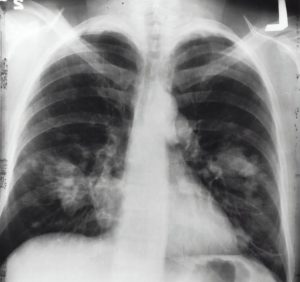New Research Shows How EVALI Illness Negatively Impacted Public Perception of Vaping
A research paper recently published by the National Bureau of Economic Research clearly shows that the public’s perception of electronic cigarettes changed for the worse during and after last year’s EVALI lung disease crisis, mainly due to media and Government scaremongering.
 In September 2019 the United States experienced an unprecedented outbreak of so-called vaping-associated lung injuries generally known as EVALI. At the time, both the Center for Disease Control and Prevention (CDC) and the Food and Drug Administration, as well as most mainstream media outlets and numerous public health experts warned the public to avoid all vaping products, ignoring the fact that e-cigarettes had been around since 2003, with no such serious health issues ever recorded.
In September 2019 the United States experienced an unprecedented outbreak of so-called vaping-associated lung injuries generally known as EVALI. At the time, both the Center for Disease Control and Prevention (CDC) and the Food and Drug Administration, as well as most mainstream media outlets and numerous public health experts warned the public to avoid all vaping products, ignoring the fact that e-cigarettes had been around since 2003, with no such serious health issues ever recorded.
As time went by and scientific data showed that the potentially life-threatening lung injuries associated with vaping were really mainly associated with the inhalation of vitamin E acetate and other toxic compounds in THC-containing vaping products, the CDC started changing its stance, going as far as changing the warnings on its website. But by that time it was too late.
As several studies have shown in the past, perceived harm of electronic cigarettes is a strong predictor if whether smokers will even try to quit or switch to vaping as a less harmful nicotine delivery method. The EVALI case in particular is an interesting one, because it involves trusted Government organizations like the CDC and FDA, the warnings of which the public tends to take very seriously.
By analyzing data from vaping surveys conducted before the EVALI epidemic, during the crisis and after it, a team of researchers showed how greatly the CDC, FDA and the media’s wrongful association of vaping with the disease affected the American public’s perception of electronic cigarettes.
In the paper, researchers mention numerous studies from 2013 to 2017, which showed that people’s general view of electronic cigarettes was that they were less harmful than combustible tobacco cigarettes. It’s true that people’s views of vaping were not static during the five year period, with one survey showing that the percentage of adults who perceived e-cigarettes to be at least as harmful as tobacco cigarettes has grown from 12.8% in 2012, to 39.8% by 2015, but on average, most people viewed vaping as a healthier alternative to smoking.
Then, in late summer 2019, the EVALI epidemic hit and things changed dramatically. Both the CDC and the FDA were quick to accuse vaping, arguing that it was the only commonality between most of the reported cases. Obviously, research on the disease and its causes was basically non-existent at the time, but that didn’t stop the two organization from blaming e-cigarettes and warning people to “refrain from using e-cigarette/vaping products, especially those with THC”. To make matters worse, the media spread these recommendations as warnings that using e-cigs was potentially.
As time passed and data increasingly showed that there was something about THC vapes that caused the serious lung injuries, the CDC continued to recommend that people “refrain from using e-cigarettes, or vaping products that
contain nicotine”. It wasn’t until December of 2019, when case analysis clearly showed an association between EVALI and the vaping of THC containing e-liquids, that the CDC finally revised its warnings, urging people to “not use e-cigarette, or vaping, products that contain THC, as data suggest these products play a major role in the current lung injury outbreak”.
The warnings of the CDC and FDA, as well as the reporting of the media during the EVALI crisis can be considered an information shock for the general public, and researchers’ analysis shows that it greatly influenced its perception of electronic cigarettes. Based on a linear trend projection, the percentage of people who perceived vaping to be more or much more harmful than smoking was predicted to be 18% in September 2019, but in reality the Google Survey data analyzed in this paper shows that the percentage was around 30%.
Google Survey data collected between September 2019 and January 2020 shows that the percentage of respondents who viewed vaping as harmful or more harmful than smocking tobacco remained stable at around 30%, with most recent samples showing a slight decline.
who viewed vaping as harmful or more harmful than smocking tobacco remained stable at around 30%, with most recent samples showing a slight decline.
“These descriptive statistics suggest that there was a sharp upward revision in the relative harm perception of e-cigarettes during the EVALI outbreak, and little downward correction even after the CDC had clarified its message to specifically apply only to THC-containing e-cigarettes,” the authors of the paper wrote.
The researchers used a number of models of how survey participants changed their perception of e-cigarette harm during and after the EVALI epidemic, and while some suggest that certain demographics were more resistant to the the original information shock and more receptive to the second (the corrections regarding THC vapes made by the CDC), on average, harm perception of e-cigarettes grew during the epidemic and dropped only slightly after it.
The National Bureau of Economic Research acknowledges that its paper is not peer-reviewed so you should definitely take its findings with a grain of salt. However, I will point out that the results of this research are consistent with those of the Morning Consult survey from earlier this year, which found that 66% percent of respondents said that they viewed e-cigarettes like JUUL as the culprit behind the EVALI crisis.
One thing that I personally think research should have considered is the role of the media in the reporting on the EVALI epidemic, more specifically their active involvement in spreading the original recommendations and comments of the CDC and FDA, and their suspicious reluctance to do the same when the CDC officially changed its stance on the issue. But it’s not like this is the first time the mainstream media has helped put vaping in a negative light.
Photo 1: NCI/Unsplash
Photo 2: kalhh/Pixabay















